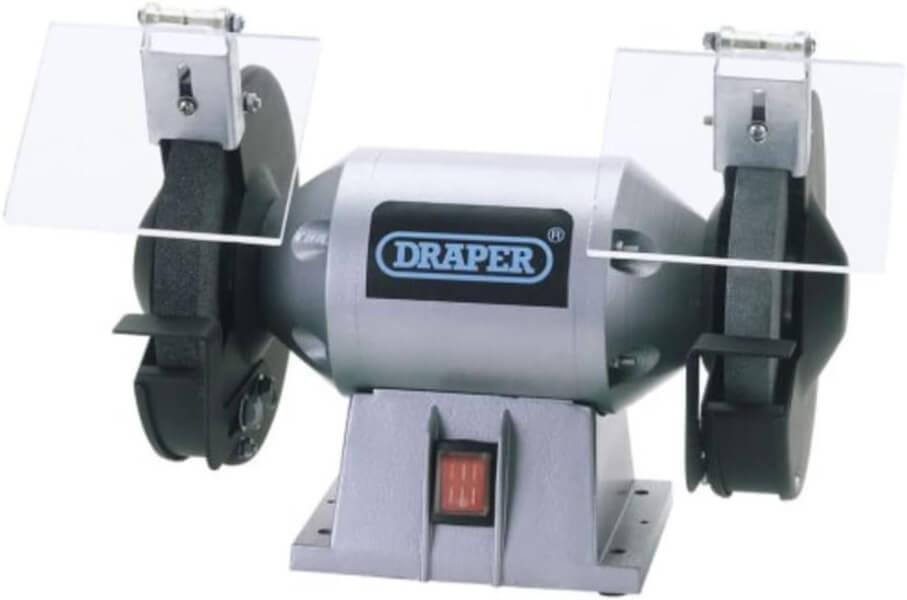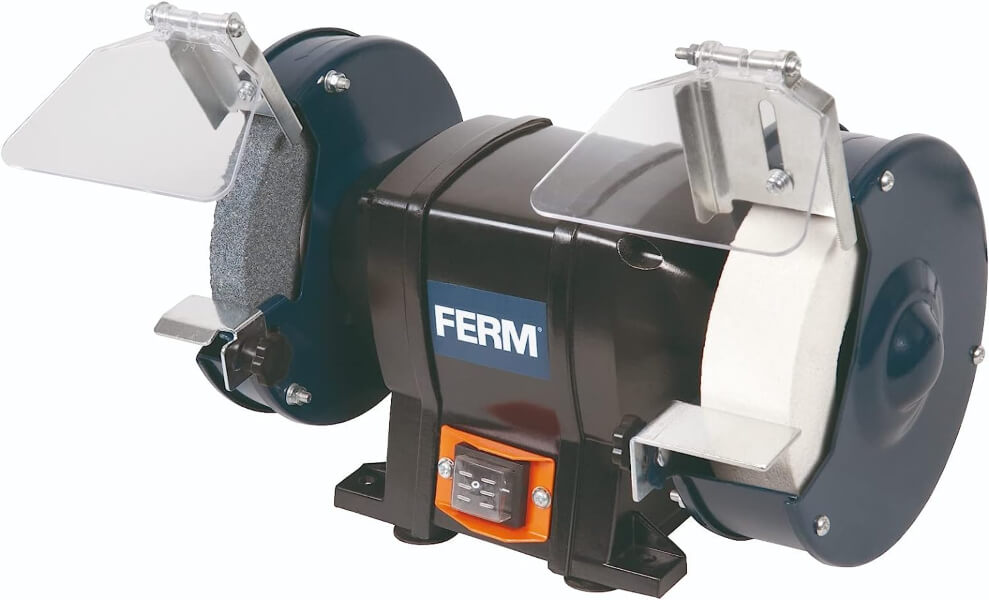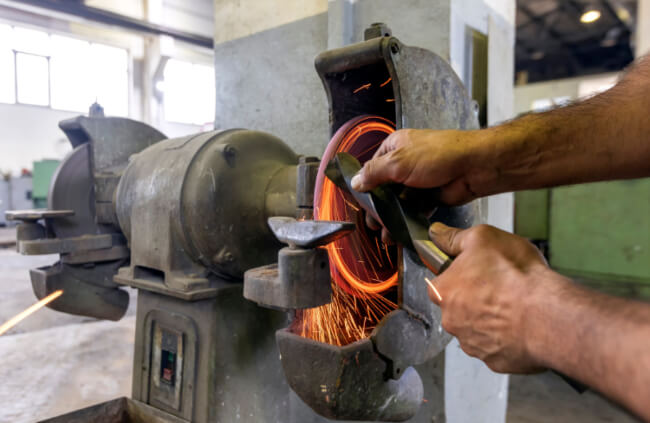If you ask any jeweller or engineer what their most time-saving tool is, they will invariably tell you it’s a bench grinder. Bench grinders are basic tools, but they save tie and produce far, far, superior finishes to sanding or filing by hand.
In this article we’re going to look at what makes a good bench grinder, why you need one, and take a look at some of the stand-out bench grinders on the market in 2025, so you don’t have to.
More...
Top Pick


Best Value


Product | Our Rating | Price | |
|---|---|---|---|
1. Draper 66804 Bench Grinder |  |  | |
2. FERM BGM1020 Bench Grinder |  |  |
Australian Buyers' Guide to Bench Grinders
What is a Bench Grinder?

Bench grinders are weighted tools, with two rotating wheels, usually with different grades, designed to file, sand, and polish metal. While they are typically supplied with grind wheels, they can be used with polishing wheels (or cloths) to buff out any fine scratches, depending on the finish you’re after in your metalwork.
There are a handful of brands making reliable bench grinders, including Draper, FERM, Einhell, and Abbott & Ashby. Most spin at roughly the same speed, with similar safety features, and most are in the same sort of price bracket.
So, to take some of the confusion out of your choice, let’s take a look at what separates the best bench grinders from the rest.
What to Look for When Buying a Bench Grinder
When you’re buying a new bench grinder, there are a few basic things to look out for; durability, weight, speed, and most importantly, the quality of fittings. Most are obvious – such as weight, where a heavier bench grinder is actually much more reliable, as it will usually stay straight and true for longer.
Others, like the quality of fittings, can be harder to assess, but looking for recognised brands, or professional-grade tools should give you some confidence in that arena.
Safety features
There are two essential safety features on any bench grinder: An accessible shut-off switch; Eye shields. Shut-off switches don’t need to be workshop quality, but they do need to be easy to see, and easy to reach.
Thanks to their simplicity, and the fact that nearly all bench grinders have one speed, they have one basic switch, that’s usually in red, or a contrasting colour to the rest of the tool.
When it comes to eye protection, it’s still worth wearing goggles, but most grinders do come with clear plastic eye guards that mount above each wheel. Regardless of how well you prepare your metals, bench grinders will produce dust, and if you slip, can even produce swarf – though this is unlikely on most metals when using a good quality wheel.
Power
Power won’t give you an indication of quality with bench grinders, but the standard power is 230 volts, which means they work on a standard home circuit without any special sockets or fuses.
Weight and fixings
Weight is surprisingly important when it comes to choosing the best bench grinder. Lightweight bench grinders can be ok when fixed securely to a sturdy workbench, but reasonably heavy bench grinders offer more stability and will last for longer, particularly if you have a tendency to put weight or pressure on the wheels while grinding.


Get Your Free Guide:
Master Growing Australian Natives eBook
A Must Have Complete Guide for Every Australian Garden
Get Your Free Guide:
Master Growing Australian Natives eBook
A Must Have Complete Guide for Every Australian Garden
Spindle fixings (is it easy to change wheels?)
It’s not often talked about but there is actually a big problem with spindles and their fixings when it comes to budget bench grinders. Spindles are part of a bench grinder that is changeable for different wheels and will allow you to attach wheels and remove them easily (or not).
You can often fix tapered spindles to your bench grinder, for a variety of polishing wheels, and the standard spindles are straight-edged, for connecting grinding wheels. However, it’s not about the spindle. It’s about how easy it is to change them. Check user reviews for set-up guides and feedback.
Size
Bench grinders come in two sizes as standard; 6-inch wheels and 3-inch wheels. But for larger work, you can get 8” grinding wheels on purpose-built grinders – but for most users, 8” wheels are unnecessary.
3” wheels are great for detail work, and are safer to use with fine metalwork, but 6” wheels are good all-around tools, which if used properly, can be great for working at most sizes.
Different Types of Bench Grinders
Bench grinders are standard tools. It’s their attachments that change, but there are a few tools, particularly from Draper and Abbot & Ashby, that offer more than the norm.

Fine Vs Coarse Bench Grinders
Nearly all bench grinders are sold with a fine wheel, and a coarse wheel, and you can change the wheels easily across most brands depending on your needs.
Wet & Dry Bench Grinders
Wet and dry bench grinders are incredible tools for finishing work in a dust-free environment and can help to cool down metals that would otherwise be difficult to grind with a bench grinder.
Linishing Bench Grinders
Linishing bench grinders are a bit different, but the base machine is the same, with a bulky attachment that fits onto existing spindles to power rotating wheels for flat surface sanding, or belt-sanding.
Linishing bench grinders are particularly useful if you work with multiple materials as they also offer a way to finish smaller pieces of woodwork, without needing to invest in a separate belt-sander.
How to Use a Bench Grinder
Bench grinders rotate towards the user, so the top of the wheel is turning towards you, and the base is turning away. This is a basic safety feature that means your metal pieces will fling downwards, not upwards if you lose your grip.
To sharpen tools, hold the face of the tool flat to the front edge grinding wheel, tilted downwards. Grind for no more than 2-3 seconds and then check. A brief sharpening should be enough.
To smooth smaller pieces, or round their edges, keep a very tight hold and carefully rotate the materials in the direction of the grinder.
Note: Bench grinders can be used in both directions, but avoid this if you can, as you will be placing the safety switch on the opposing side. If you want the option to use a bench grinder in both directions, buy one that has the option as standard, rather than amending a more basic model.
Safety Guide for Bench Grinders
Before using your bench grinder for the first time, make sure it is firmly attached to a stand or a workbench. Bench grinders should be used slightly above waist height, away from your face, regardless of the protective equipment you’re using.
Linishall makes a great bench grinder stand, which fits most brands and allows you to work around the tool at an angle that suits you. Once your bench grinder is firmly mounted in position, make sure its wheels are tightly fitted, and that the shut-off switch is facing forwards for easy access. Then secure any eye protection shields so that they stand securely between your face and the wheel.
It’s also important to remove ties, jewellery, and any loose glasses that could get caught in the machine. Long sleeves should be buttoned or tight-fitting. Any loose or dangling clothing could drag your hand into the grinder.
Bench Grinder Reviews
1. Draper 66804 Bench Grinder

Draper 66804
Draper’s 150mm bench grinder comes with one coarse and one fine grinding wheel as standard. It is the basic standard tool for most workshops because it’s affordable, functional and reliable.
I have three of these grinders in my workshop with different grades of wheel, including some polishing wheels, and they have never, ever let me down. While draper might not be a household name for DIYers, it’s the go-to for most jewellers, and well worth investing in.
Pros
Cons
2. FERM BGM1020 Bench Grinder

FERM BGM1020
FERM is a great budget option for anyone looking to test out bench grinders for themselves. Their bench grinders are easy to use and set up, and while they are a little lighter than I’d like, they work well for buffing, or light grinding work, and can be used with pretty much any wheel.
If you’re on a budget, I’d strongly recommend the FERM bench grinder, which is as powerful as any other, and well-built too.
Pros
Cons
Bench Grinder Top Picks for 2025
Top Rated Bench Grinder


My favourite bench grinder is still the one I’ve had for years. It’s a standard workshop tool that you’ll find in public and private workshops all over Australia and has truly earned its trust. It’s the Draper 150 mm bench grinder, with basic but durable safety guards, a simple shut-off switch, and durable, easy-to-change wheels.
If you want to know you’re buying a bench grinder that will last, without worrying too much about cost, this should be the go-to bench grinder for everyone.
Best Value Bench Grinder


The best budget bench grinder out there right now is FERM’s 150mm bench grinder. Is it basic? Yes. Does it work? Yes. OK, so it's not the most exciting bench grinder out there, but at nearly half the price, it’s a perfect addition to any home workshop, and it’ll cost a fraction of any other bench grinder you could buy, and does an almost identical job – particularly when used with polishing wheels.
Bench Grinders Frequently Asked Questions
What bench grinder size is best?
Smaller bench grinders, 3 inches, are ideal for detailed work, particularly with metal crafts, but 6-inch bench grinders are easier to use, and more general purpose. If you can only afford one, go for a 6-inch bench grinder, which has more potential uses.
What are bench grinders most used for?
Bench grinders are used for shaping, sanding, and smoothing metal. They can be used to sharpen metal tools, and smooth out rough surfaces before polishing and sanding to a buff finish.
Does a bench grinder need to be bolted down?
Bench grinders should always be bolted down. They are heavy, powerful tools that spin incredibly quickly. If the spindle falls off centre, your machine will wobble excessively and will likely cause you harm if it is not bolted down.
Do you need training to use a bench grinder?
A properly installed bench grinder is easy to use and does not require training. However, you should familiarise yourself with the manufacturer’s instructions, make sure you are familiar with the shut-off switches (or install an emergency shut-off for the workshop), and understand the basics of how to hold and position your materials.
What materials can you grind on a bench grinder?
There are attachments for bench grinders that mean they can be used with nearly all materials but the standard use of any bench grinder is metal. Polishing wheels, grinding wheels, and sanding wheels are designed to work with metal.
What materials can you not grind on a bench grinder?
Aluminium, and any metal with a low melting point, will damage a grinding wheel as the extreme heat caused by friction will melt the materials.
Does a bench grinder need an emergency stop?
Bench grinders do not strictly need an emergency stop button, but they can catch clothes, ties, and jewellery so it’s worth connecting them to a room with a clear emergency stop, or installing a stop switch nearby.
Why do bench grinders have two wheels?
Bench grinders have two wheels because each wheel is typically a different grade – usually a fine grade and a coarse grade. Start grinding your materials on the coarse wheel, and finish with fine grade before polishing with wet and dry paper by hand for a perfect finish.
For more power tool product reviews and buying guides, check out our list below:
Wrapping Up Our Guide to Choosing the Best Bench Grinder for 2025
Bench grinders are simple tools, but with tons of potential polishing attachments, and different grades of grinding wheels, they can be amended to be more or less complicated to match your needs.
Here, we use three Draper bench grinders, each with different grades of wheel to finish fine silver sculpture. Our less powerful FERM is ideal for polishing cloths, which buffs out any final scratches and scrapes from a perfect gloss finish on most metals.
Choosing the best bench grinder means choosing the best grinder for you. This is truer with bench grinders than with most other tools, as every attachment, and every grinder has its own unique pros and cons. The best all-rounder though? The 6-inch Draper 230 Volt Bench Grinder. Ideal for beginners and pros alike.
Published on July 15, 2023 by Gary Clarke
Last Updated on December 23, 2025




